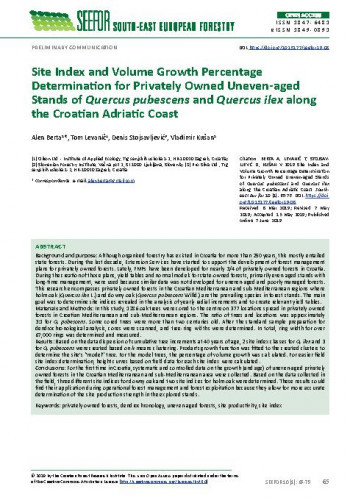Background and Purpose: Although organized forestry has existed in Croatia for more than 250 years, this mostly entailed state forests. During the last decade, Extension Services have started to support the development of forest management plans for privately owned forests. Lately, FMPs have been developed for nearly 3/4 of privately owned forests in Croatia. During the creation of those plans, yield tables and normal models for state-owned forests, primarily even-aged stands with long-time management, were used because similar data was not developed for uneven-aged and poorly managed forests. This research encompasses privately owned forests in the Croatian Mediterranean and sub-Mediterranean regions where holm oak (Quercus ilex L.) and downy oak (Quercus pubescens Willd.) are the prevailing species in forest stands. The main goal was to determine site indices revealed in the analysis of yearly radial increments and to create relevant yield tables. Materials and Methods: In this study, 1286 oak trees were cored to the centre on 377 locations spread in privately owned forests in Croatian Mediterranean and sub-Mediterranean regions. The ratio of trees and locations was approximately 3:1 for Q. pubescens. Some cored trees were more than two centuries old. After the standard sample preparation for dendrochronological analysis, cores were scanned, and tree-ring widths were determined. In total, ring width for over 67,000 rings was determined and measured. Results: Based on the data dispersion of cumulative tree increments at 40 years of age, 2 site index classes for Q. ilex and 3 for Q. pubescens were created based on k-means clustering. Prodan’s growth function was fitted to the created clusters to determine the site’s “model” tree. For the model trees, the percentage of volume growth was calculated. For easier field site index determination, height curves based on field data for each site index were calculated.
Sažetak

 South-east European forestry : SEEFOR : international scientific journal in field of forestry : 10,1(2019) / editor-in-chief Dijana Vuletić.
South-east European forestry : SEEFOR : international scientific journal in field of forestry : 10,1(2019) / editor-in-chief Dijana Vuletić.